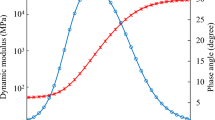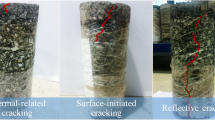Abstract
One of the most commonly observed distress in asphalt pavement is shrinkage cracking, which has a significant negative impact on the service life of asphalt pavement. The primary purpose of this study is to evaluate the effects of shrinkage or transverse cracking of asphalt pavement on the load transfer efficiency (LTE) by using data obtained from the portable falling weight deflectometer (PFWD) device. So, the pavements of two roads, which were different in thickness, asphalt mix design, and service life, were chosen. The deflections of about 800 different transverse cracks were then measured by the PFWD device. After the evaluation of the collected data, a new equation was proposed for the calculation of the LTE, which is expected to be more accurate than previous equations. A Finite Element (FE) model was then developed by ABAQUS to investigate the LTE of transverse cracks with high accuracy. After the comparison between the developed model and the collected data, the correctness of this model was verified. Also, the effects of some important factors, including the asphalt concrete thickness, and asphalt concrete and base course modulus on the LTE, were investigated in the FE model. The results of field data and FE analyses indicated that the LTE of transverse cracks in asphalt pavement depends on both cracks' widths and the asphalt layer's thickness. The results revealed that when the cracks' widths and the thickness of the asphalt layer increase, the LTE value decreases. Moreover, the results of the FE model analysis for the asphalt concrete and base course indicated that the effect of the asphalt concrete modulus on the LTE was negligible; however, the base course modulus had a considerable impact on the LTE. Hence, the LTE values can be estimated by using the developed model, transverse cracks' widths, and the thickness of asphalt pavement without using the PFWD device.




















Similar content being viewed by others
References
Shahin, M.Y. (1994). Pavement management for airports, roads, and parking lots.
Yin, H. M. (2010). Opening-mode cracking in asphalt pavements: Crack initiation and saturation. Road Materials and Pavement Design, 11, 435–457.
Zhang, W., Shen, S., Basak, P., Wen, H., Wu, S., Faheem, A., & Mohammad, L. N. (2015). Development of predictive models for initiation and propagation of field transverse cracking. Transportation Research Record, 2524, 92–99.
Shamsaei, M., Aghayan, I., & Kazemi, K. A. (2017). Experimental investigation of using cross-linked polyethylene waste as aggregate in roller compacted concrete pavement. Journal of Cleaner Production, 165, 290–297.
Mammeri, A., Vaillancourt, M., & Shamsaei, M. (2023). Experimental and numerical investigation of using waste glass aggregates in asphalt pavement to mitigate urban heat islands. Clean Technologies and Environmental Policy, 2, 1–14.
Shamsaei, M., Carter, A., & Vaillancourt, M. (2022). A review on the heat transfer in asphalt pavements and urban heat island mitigation methods. Construction and Building Materials, 359, 129350.
Aghayan, I., & Khafajeh, R. (2019). 12 - Recycling of PET in asphalt concrete. In F. Pacheco-Torgal, J. Khatib, F. Colangelo, & R. Tuladhar (Eds.), Use Recycl. Plast. Eco-Efficient Concr. (pp. 269–285). New York: Woodhead Publishing.
Shamsaei, M., Khafajeh, R., & Aghayan, I. (2019). Laboratory evaluation of the mechanical properties of roller compacted concrete pavement containing ceramic and coal waste powders. Clean Technologies and Environmental Policy, 21, 707–716. https://doi.org/10.1007/s10098-018-1657-5
Shamsaei, M., Khafajeh, R., Ghasemzadeh Tehrani, H., & Aghayan, I. (2020). Experimental evaluation of ceramic waste as filler in hot mix asphalt. Clean Technologies and Environmental Policy, 22, 535–543. https://doi.org/10.1007/s10098-019-01788-9
Aghayan, I., Khafajeh, R., & Shamsaei, M. (2021). Life cycle assessment, mechanical properties, and durability of roller compacted concrete pavement containing recycled waste materials. International Journal of Pavement Research and Technology, 14, 595–606. https://doi.org/10.1007/s42947-020-0217-7
Khazanovich, L., Velasquez, R., & Nesvijski, E. G. (1940). Evaluation of top-down cracks in asphalt pavements by using a self-calibrating ultrasonic technique. Transportation Research Record, 2005, 63–68.
Tertre, A., Cascante, G., Tighe, S.L. (2010). Combining PFWD and surface wave measurements for evaluation of longitudinal joints in asphalt pavements. In: Proc. Transp. Res. Board Annu. Meet., pp. 1–18.
Solla, M., Lagüela, S., González-Jorge, H., & Arias, P. (2014). Approach to identify cracking in asphalt pavement using GPR and infrared thermographic methods: Preliminary findings. NDT&E International, 62, 55–65.
Koduru, H. K., Xiao, F., Amirkhanian, S. N., & Juang, C. H. (2010). Using fuzzy logic and expert system approaches in evaluating flexible pavement distress: Case study. Journal of Transportation Engineering, 136, 149–157.
Tomoto, T., & Moriyoshi, A. (2009). Evaluation of damage to asphalt pavements using a micro-focus CT scanner and three-dimensional crack analysis. Road Materials and Pavement Design, 10, 519–543.
Lee, N.-K., Hugo, F., & Stokoe, K. H. (1997). Detection and monitoring of cracks in asphalt pavement under Texas mobile load simulator testing. Transportation Research Record, 1570, 10–22.
Nazzal, M. D., Abu-Farsakh, M. Y., Alshibli, K., & Mohammad, L. (2016). Evaluating the light falling weight deflectometer device for in situ measurement of elastic modulus of pavement layers. Transportation Research Record, 2007, 13–22.
Dwivedi, S., & Suman, S. K. (2023). A comprehensive review on non-destructive testing using LWD and Geogauge for quick QC/QA of pavement layers. Innovative Infrastructure Solutions, 8, 101.
Lin, D.-F., Liau, C.-C., & Lin, J.-D. (2006). Factors affecting portable falling weight deflectometer measurements. Journal of Geotechnical and Geoenvironmental Engineering, 132, 804–808.
Liu, P., Xing, Q., Dong, Y., Wang, D., Oeser, M., & Yuan, S. (2017). Application of finite layer method in pavement structural analysis. Applied Sciences, 7, 611.
Sadeghi, V., & Hesami, S. (2018). Investigation of load transfer efficiency in jointed plain concrete pavements (JPCP) using FEM. International Journal of Pavement Research and Technology, 11, 245–252.
Fu, G., Zhao, Y., Wang, G., & Wei, J. (2022). Evaluation of the effects of transverse cracking on the falling weight deflectometer data of asphalt pavements. International Journal of Pavement Engineering, 23, 3198–3211.
Deng, Y., & Yang, Q. (2019). Rapid evaluation of a transverse crack on a semi-rigid pavement utilising deflection basin data. Road Materials and Pavement Design, 20, 929–942.
Park, S.-W., Park, H. M., & Hwang, J.-J. (2010). Application of genetic algorithm and finite element method for backcalculating layer moduli of flexible pavements. KSCE Journal of Civil Engineering, 14, 183–190.
Aminzadeh, M., Kazemi, H. S., & Tavakkoli, S. M. (2020). A numerical study on optimum shape of steel slit dampers. Advances in Structural Engineering, 23, 2967–2981.
Aminzadeh, M., & Tavakkoli, S. M. (2022). A parameter space approach for isogeometrical level set topology optimization. Int. J. Numer. Methods Eng., 123, 3485–3506.
Irvani, M., Ezati, H., Khafajeh, R., & Kalat Jaari, V. R. (2022). Numerically study on the seismic response of partially restrained moment connection with structural fuse T-stub for European sections. Structures., 35, 82–105. https://doi.org/10.1016/j.istruc.2021.10.078
Owusu-Anti, E.B., Meyer, A.H., Hudson, W.R. (1990). Assessing load transfer across joints and cracks in rigid pavements using the falling weight deflectometer, Center for Transportation Research, Bureau of Engineering Research.
Khazanovich, L., Gotlif, A. (2003). Evaluation of joint and crack load transfer final report, United States. Federal Highway Administration. Office of Infrastructure.
Shoukry, S. N., William, G. W., & Riad, M. Y. (2005). Evaluation of load transfer efficiency measurement. Pennsylvania State University.
Cunliffe, C. (2014). Impact of structure, material properties, temperature curling, and trafficking on load transfer efficiency.
Wadkar, A., Mehta, Y., Cleary, D., Guo, E., Musumeci, L., Zapata, A., & Kettleson, W. (2011). Load-transfer efficiencies of rigid airfield pavement joints based on stresses and deflections. Journal of Materials in Civil Engineering, 23, 1171–1180.
Lin, C., Guo, Z.Y., Fang, J.G., Yang, Y.S. (2006) Analysis and evaluation of transverse-cracked semi-rigid base asphalt pavements using FWD data. In: Pavement Mech. Perform, pp. 1–6.
Yu, X., Wu, X. (2010). Joint load transfer efficiency of rigid pavement considering dynamic effects under a single moving load. In: 2010 2nd Int. Conf. Inf. Eng. Comput. Sci., IEEE, pp. 1–4.
Cunliffe, C., Joshi, A., Mehta, Y., & Cleary, D. (2014). A study to determine the impact of cracking on load transfer efficiency of rigid airfield pavements. Journal of Testing and Evaluation, 42, 375–389.
Yang, Q., & Deng, Y. (2019). Evaluation of cracking in asphalt pavement with stabilized base course based on statistical pattern recognition. International Journal of Pavement Engineering, 20, 417–424.
Zhou, L., Ni, F., & Zhao, Y. (2010). Evaluation method for transverse cracking in asphalt pavements on freeways. Transportation Research Record, 2153, 97–105.
Park, H. J., Eslaminia, M., & Kim, Y. R. (2014). Mechanistic evaluation of cracking in in-service asphalt pavements. Materials and Structures, 47, 1339–1358.
Wei, J. G., & Wang, B. (2013). PFWD’s application in the evaluation of structural strength of field hot regeneration asphalt pavement. Advances in Materials Research, 723, 141–148.
du Tertre, A., SerhanKırlangıç, A., Cascante, G., & Tighe, S. L. (2022). A non-destructive approach for the predictive master curve of ASPHALT pavements using ultrasonic and deflection methods. International Journal of Pavement Research and Technology, 23, 1540–1551.
Khafajeh, R., Shamsaei, M., Tehrani, H. G., & Easa, S. M. (2021). Proposing Load Transfer Efficiency as Criterion for Repairing Longitudinal and Transverse Cracks of Asphalt Pavements. Journal of Transportation Engineering, Part B: Pavements, 147, 6021002. https://doi.org/10.1061/JPEODX.0000301
Uddin, W., Zhang, D., & Fernandez, F. (1994). Finite element simulation of pavement discontinuities and dynamic load response. Transportation Research Record, 2, 2.
Qiu, X., Yang, Q., & Wang, F. (2014). Diagnostic analysis of dynamic deflection for cracked asphalt pavements under FWD impulsive loading. Journal of Vibroengineering, 16, 2426–2437.
Xie, Z., Shen, J., Guo, Z., & Cong, L. (2015). Effect of distresses on deflection basins and backcalculation modulus of asphalt pavement with cement-treated base. International Journal of Pavement Research and Technology, 8, 283.
Kim, Y.R., Lee, Y.-C., Park, S., Ranjithan, S.R. (1999). Interpretation of fwd data when pavement layers are not intact.
Li, M., Wang, H., Xu, G., & Xie, P. (2017). Finite element modeling and parametric analysis of viscoelastic and nonlinear pavement responses under dynamic FWD loading. Construction and Building Materials, 141, 23–35.
Zhao, Y., Cao, D., & Chen, P. (2015). Dynamic backcalculation of asphalt pavement layer properties using spectral element method. Road Materials and Pavement Design, 16, 870–888.
Picoux, B., El Ayadi, A., & Petit, C. (2009). Dynamic response of a flexible pavement submitted by impulsive loading. Soil Dynamics and Earthquake Engineering, 29, 845–854.
Bazi, G., Gagnon, J., Sebaaly, P., & Ullidtz, P. (2020). Effects of Rayleigh damping on the subgrade’s apparent nonlinearity. Journal of Transportation Engineering, Part B: Pavements, 146, 04020042. https://doi.org/10.1061/jpeodx.0000194
Shoukry, S. N., Fahmy, M., Prucz, J., & William, G. (2007). Validation of 3DFE analysis of rigid pavement dynamic response to moving traffic and nonlinear temperature gradient effects. International Journal of Geomechanics, 7, 16–24.
Lahitou, L.A., Choi, S.-C., Won, M.C. (2008). Debonding in bonded concrete overlays over continuously reinforced concrete pavements., Texas. Dept. of Transportation. Research and Technology Implementation Office.
Perez, S. A., Balay, J. M., Tamagny, P., & Petit, C. (2007). Accelerated pavement testing and modeling of reflective cracking in pavements. Engineering Failure Analysis, 14, 1526–1537.
Author information
Authors and Affiliations
Corresponding author
Ethics declarations
Conflict of interest
The authors would like to declare that they have no conflict of interest.
Rights and permissions
Springer Nature or its licensor (e.g. a society or other partner) holds exclusive rights to this article under a publishing agreement with the author(s) or other rightsholder(s); author self-archiving of the accepted manuscript version of this article is solely governed by the terms of such publishing agreement and applicable law.
About this article
Cite this article
Khafajeh, R., Shamsaei, M., Irvani, M. et al. The Development of a Finite Element Model for the Estimation of Load Transfer Efficiency in Transverse Cracks of Asphalt Pavement. Int. J. Pavement Res. Technol. (2023). https://doi.org/10.1007/s42947-023-00334-7
Received:
Revised:
Accepted:
Published:
DOI: https://doi.org/10.1007/s42947-023-00334-7




